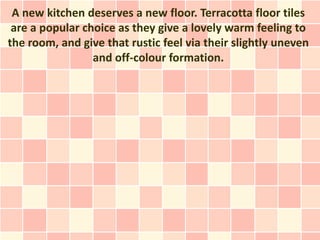
Laying Terracotta Floor Tiles
- 1. A new kitchen deserves a new floor. Terracotta floor tiles are a popular choice as they give a lovely warm feeling to the room, and give that rustic feel via their slightly uneven and off-colour formation.
- 2. So, you've got a big pile of tiles and an empty floor. Let's get cracking!
- 3. First, is the floor level? You can gauge this to a degree by eye, but you would be better advised to use a laser level. If there is a significant degree of slope, take a look into sorting this out with some floor leveller. This is a really simple thing to do - just follow the instructions for mixing, trowel out to every corner of the room, and from there, just let it do its thing and self-level. You may need to do a little further coaxing with the trowel if you've been a little uneven with the application. Regardless, let it dry and you should end up with a nice smooth finish.
- 4. As terracotta floor tiles are thicker and heavier than normal tiles, you're going to need a thicker adhesive bed. This will also help to deal with uneven tiles or those that have bowed slightly during manufacture. Don't be tempted to use a sand and cement mix for this - because terracotta floor tiles are porous, they may react with the cement, allowing the soluble salts to show through as a white stain.
- 5. Starting in one corner of the room, mix the adhesive to the manufacturer's guidelines and apply. Depending on the type of adhesive, you might have to apply it to the floor and spread out, or apply it to the back of the tile.
- 6. Now press your tile down - not too much; you're not looking to squeeze the adhesive out at the sides! Using a tile spacer, determine the position of the next tile and repeat the process. You should be checking each tile with a spirit level - in both directions. Alternatively you can use a level piece of wood (a baton), to check the level of a group of tiles.
- 7. At some point you will need to cut tiles. Because terracotta floor tiles are thick, you've going to need an angle grinder, with an attached stone-cutting wheel. Partially, cut the tile (like a deep score), then snap it. Under no circumstances stand directly over the grinder - always stand to the side. And use goggles!
- 8. Once the tiles are laid and set, apply a sealant layer before you grout. Choose a colour that closely matches your tiles and make sure the tiles are free of dust before applying.
- 9. After that has dried you can move onto grouting. Use a pointing trowel for this and try to avoid getting any of the grout on the tiles. If you do, just wipe it clean with a damp rag.
- 10. After the grout is dried a further sealant layer can be applied. You won't need to use as much as you did last time as the surface will be less porous.
- 11. Laying floor tiles is really something anyone can do - you just need to take a bit of care!